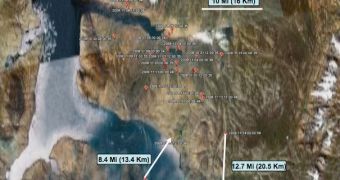Scientists at the United States Geological Survey (USGS) are currently tracking a large pack of wolves via satellite. The animals live in an area roughly 600 kilometers away from the North Pole, and their habits are of great interest to researchers, who have until now had no luck in observing them via other methods. The way they manage to track the animals now is through data sets sent by a collar attached to the leader of the pack, known as Brutus. The instrument on the collar is able to send data via satellite, alerting the USGS team about the hunting habits and movements that the pack makes.
“We first encountered 9-year-old Brutus back in 2003. This year, we made a huge technological jump from notebook and pens to satellite collars because we wanted to find out what these arctic wolves do in winter in areas when it is dark 24 hours a day and temperatures can fall to -70 degrees Fahrenheit. How far must they travel to obtain enough food to make it to the Arctic spring, which doesn't happen until the next June?” famous USGS wolf researcher David Mech says. He has spent his last 24 years studying the creatures, in their natural habitat on Ellesmere Island.
The thing about this particular island is that it's located so close to the North Pole that it only benefits from one month of summer, in July. June is something like spring, only a spring that doesn't come every year. In August, it already begins to snow, and it keeps doing so until next year. For all the other months, it's impossible to get to Ellesmere Island, so researchers cannot keep an eye on the wolves and their habits. The USGS team now hopes that the collar will shed some light on how they are able to hunt in darkness, and also on the locations that other animals, which the wolves hunt as prey, use to pass the long winter.
Thus far, the collar has transmitted more than 145 different locations for the wolf pack, the team explains. “With a recent download, I noticed that Brutus – and probably several other pack members – had traveled to the north side of a fjord to an area frequented by muskoxen, about 25 miles north of where the pups are. Because the locations are precise to within a few yards or meters, next summer we will use hand-held GPS units to check these sites for bones,” Mech adds.

 14 DAY TRIAL //
14 DAY TRIAL //